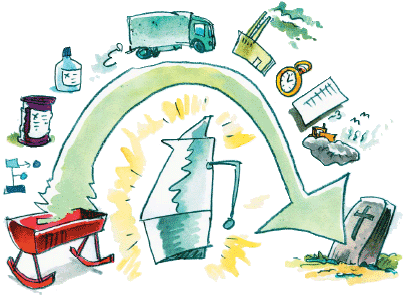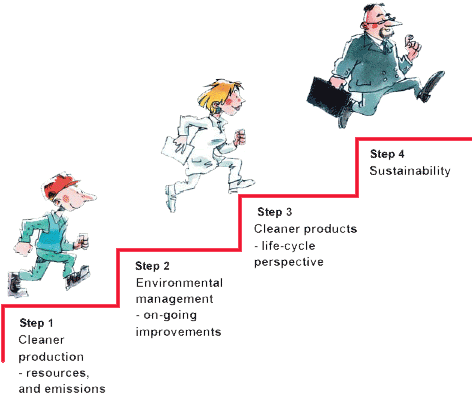An introduction to Life-Cycle Thinking and Management
1. Life-cycle-based environmental initiatives

From Cradle to Grave
Life-cycle-based environmental initiatives involve developing products which have improved environmental characteristics throughout the product's life cycle, from cradle to grave.
In the past, enterprises have primarily focused on environmental improvements to the production processes within the enterprise's own perimeter fence. Lifecycle based environmental initiatives focus on improvements to the product in all phases, from raw material extraction and transport, to production and consumption, to re-use or disposal.

Figure 1.
The life cycle of a product - and closing the resource cycle
A life-cycle-based environmental initiative provides an opportunity to get an overview of the enterprise's situation and to weigh the advantages and disadvantages associated with various choices. For example, would the disadvantages associated with an environmentally problematic material in the production process be counterbalanced by doubling product durability? Composite materials reduce the weight of a car and thereby contribute to decreased fuel consumption in the use-phase of the product. But does this advantage outweigh the disadvantage that recycling of composite materials is often problematic?
A life-cycle assessment provides an opportunity to obtain an overview over the advantages and disadvantages associated with various choices which arise during the various phases in a product's life cycle from cradle to grave. Such an overview also gives the opportunity to develop new initiatives. Is there, for example, a new method to recycle composite materials? Via an environmental / life-cycle assessment it is possible to obtain more detailed knowledge which provides a sound foundation for subsequent decision-making and final choices.
A life-cycle perspective demands more from an enterprise's environmental initiatives, but also provides the possibility for significant advantages, for example: an improved market position compared to the competitors; an improved market image; closer cooperation with suppliers and customers regarding product development and marketing; as well as better relations with environmental and other authorities and with other collaborative partners.
Enterprises begining life-cycle-based environmental initiatives NOW have a greater possibility of realising these advantages than if they wait to see what the competitors are doing.
From cleaner production via environmental management to cleaner products
Over the last decade, Danish enterprises have gradually been taking more responsibility for the environment: from environmental optimisation of production, via a commitment to make continuous environmental improvements, to development and marketing of cleaner products. These represent three different steps in a preventative environmental initiative, which is in itself a step towards sustainable development taking into account economic, social and environmental issues.
Cleaner production processes
When an enterprise has optimised production by reducing water and energy consumption, by substituting harmful materials, and by introducing the best available technology to reduce discharges and emissions, then an enterprise's products are cleaner, all else being equal. Cleaner production is a first step towards cleaner products.
Environmental management
Environmental management often focuses initiatives on the environmental conditions within the enterprise's own property and makes demands for continuous improvements.With this focus, environmental initiatives can gradually be expanded to include for example, environmentally optimised goods transport, collaboration with suppliers regarding phase-out of harmful substances, information to consumers regarding environmentally friendly product use, etc.

Figure 2.
Various approaches to life-cycle-based environmental initiatives.
Life-cycle-based environmental management is a step further towards cleaner products.
Cleaner products
When an enterprise focuses on improving the environmental characteristics of a product, all departments must contribute including product development, production, sales and marketing, procurement, and transport. Similarly, it requires increased collaboration with suppliers and consumers, regarding environmental improvements and to meet the criteria for the Swan and EU Flower ecolabels.
Cleaner products and eco-labelling make direct use of environmental characteristics as a parameter in market competition.
An enterprise may use all three steps towards producing cleaner products.The enterprise selects the level which best matches its goals and level of ambition, its previous experience, and the resources available.
Three examples from Danish enterprises
Many Danish enterprises have undertaken extensive environmental initiatives corresponding to one or more of the above "steps". Increasingly, industries are taking their responsibility for the environment seriously which, in accordance with Danish and EU environmental policy, involves preventative action at the source, closure of the raw material cycles, the "polluter pays" principle, and sustainable development.
Printline is a print production company in Odense with 30 employees. In the late 1990's, the enterprise began to make changes to the print production process so that the use of lead and tin was replaced with silver. Printline realised a number of advantages with this new production process: the use of silver represents only one percent of the previous quantity of tin and lead; water and energy consumption have fallen by 80 to 90 percent; the production flow operates four times faster; the work-place climate has improved; the quality of the product has improved, as the surface is now more flat, etc.
Substitution of silver in the place of the undesirable metals has created a cleaner production process, and thus also cleaner printed circuit boards.Together, substitution and cleaner production are steps towards cleaner products.
In 1993, Phønix Printing in Århus was the first Danish enterprise to introduce a certified environmental management system. According to the enterprise's environmental accounts, the staff now includes 71 quality and environment managers (= employees).The enterprise has since obtained a licence to use the Swan eco-label on their products.Today, a quarter of the enterprise's trade is in Swan-labelled printed matter and Phønix is working towards increasing this segment via customer guidance, partnerships and general dialogue.
Environmental management can take a product-orientated direction, and thus become a tool, assisting enterprises to develop and market cleaner products. "Green Cotton" is a product concept based on a life-cycle perspective which the company Novotex launched in the late 1980's. The central phases in the life cycle of a cotton product were identified. Then, for each phase, the health and safety and environmental problems were roughly assessed. Based on this information Novotex has had on-going collaboration with its suppliers to reduce the environmental impact of cotton products. At the same time, the enterprise has been working with cleaner technology, introduced an EMAS environmental management system, and eco-labelled some of its textile products.
A cleaner product concept is a good platform from which an enterprise can begin to work with environmental management, eco-labelling, and collaboration with suppliers.
Supply and demand - which comes first?
Developments and initiatives in the environmental field have often been driven by demands from authorities. A productorientated environment policy, also referred to as an integrated product policy (IPP), places some of the responsibility in the hands of the enterprise and the consumer.

Demand for cleaner products on the market must be created: and creating demand is a gamble. On the one hand, an enterprise can, to a certain degree, claim that consumers do not demand cleaner products. On the other hand, consumers may claim that enterprises do not produce and offer cleaner products.
This is a difficult "chicken and egg" situation. But enterprises must take a gamble and make investments in the environment, betting that there will be advantages in the future. The list of possible advantages is long (see chapter 2).